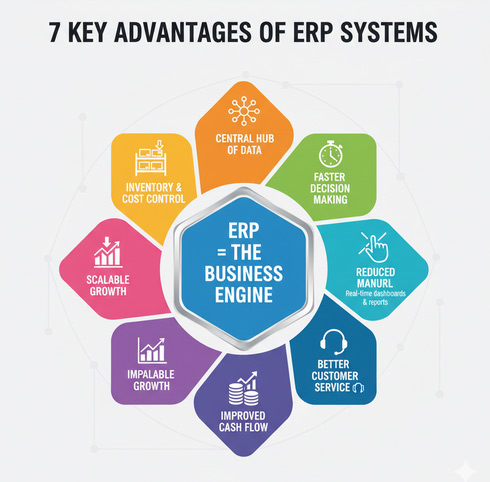Advantages And Disadvantages Of ERP (Complexity, Efficiency, Productivity, And Merits)
Your accounts team doesn't integrate with inventory. HR tracks everything on spreadsheets. Sales reps use different software, and when you need a simple report, it takes three people and two days to get basic numbers.
Sounds relatable? Welcome to the chaos that drives most business owners crazy.
Then came ERP software that promised to fix this mess by connecting everything in one platform. Finally, firms have one master control instead of five remote controls for different functions.
However, here's the reality check: the advantages of ERP aren't as straightforward as vendors claim. Yes, ERP can transform operations and boost productivity dramatically. It can also become an expensive nightmare. After all, the benefits and limitations of ERP packages you reap depend heavily on choosing the right system for your business size and needs.
That's exactly why smart CTOs and CEOs understand all the ERP merits and demerits before deciding.
In this article, we'll explore the advantages and disadvantages of ERP systems so you can decide whether it's the right investment for your organisation.

Advantages And Disadvantages Of ERP
Before jumping right to what are the advantages and disadvantages of ERP software, let's first understand what an ERP is, and why more than 50% businesses consider ERP a priority investment today.
So, ERP stands for Enterprise Resource Planning. It's business software that connects different departments through one shared database. These include primary departments like accounting & finance, project management, HR, supply chain, sales, manufacturing, warehouse logistics, and customer support. This way, an ERP system provides a single source of truth.
ERPs cater to all organisational types, ranging from small startups and growing mid-size firms to global enterprises & MNCs. With ERP, you get faster reporting, reduced manual work, better inventory control, and improved customer service. Staff spend less time hunting for information and more time on productive tasks.
That said, ERP isn't a one-size-fits-all solution. While the
benefits of ERP automation
are impressive, there are also challenges associated with implementation, including cost
and adaptability.
So, let's discuss the advantages and
disadvantages of
ERP implementation process
in detail so you can see the full picture, whether to move ahead or not at the moment.
Advantages Of ERP
ERP software can feel complex, but its value becomes clear once you see how it improves day-to-day business operations. And while every company uses ERP in a slightly different way, the benefits typically fall into a few clear areas.
So, let's explore some of the biggest advantages of ERP:

1. Central Hub of All Business Data
One of the first things companies notice after implementing ERP is how it centralizes data. Nearly 74% of organizations reported that ERP helped improve data integration
See, traditionally, departments like finance, HR, and supply chain worked in their own systems. Information was scattered, duplicated, and often out of sync. If one team needed data from another, they usually had to wait for approvals or manually share files.
With ERP, that problem disappears:
Sales forecasts auto feed into inventory module → inventory knows what's needed.
Finance sees forecast + inventory + orders in one dashboard. No chasing.
If there's a mismatch (say, an order more than inventory), alerts happen automatically.
Instead of teams working with disconnected data, ERP creates a shared view for everyone. This integration not only eliminates data silos but also ensures accuracy across the business.
2. Faster Decision Making with Real-Time Reports
Manual reporting takes days or weeks to compile. By the time you get numbers, they're already outdated. ERP generates reports instantly using current data from all departments.
Need to check cash flow? The system pulls latest receivables, payables, and inventory values automatically. Want to see which products sell best? Sales data combines with profitability analysis in real-time.
Custom dashboards show exactly what matters to your business. While competitors are still "checking and getting back," you're confirming the order. A manufacturing client told us they closed 40% more deals simply because they could give accurate quotes immediately instead of the usual "we'll get back to you tomorrow" response.
With ERP, you don't have to make decisions in a hassle, you can check the KPI metrics and make strategic decisions.
3. Reduced Manual Work and Human Errors
Data entry across multiple systems wastes hours daily. Staff copy information from one system to another, creating opportunities for mistakes. ERP eliminates this duplicate work through automated processes that modern businesses rely on.
When someone places an order, the system updates inventory, creates accounting entries, and schedules production automatically. No manual steps. No typing errors. No forgotten updates.
Invoice processing becomes automatic when purchase orders match delivery receipts. Payment approvals trigger based on predefined rules. Month-end closing occurs more efficiently because all data remains synchronized throughout the month.
4. Better Customer Service and Satisfaction
Customer service improves dramatically when representatives access complete customer information instantly. Order history, payment status, support tickets, and preferences appear on one screen.
Customers get accurate delivery dates because the system checks real inventory levels and production schedules. No more promising items that aren't available or giving vague "we'll get back to you" responses.
Support teams resolve issues faster with complete visibility into past interactions. They see what solutions worked before and avoid repeating unsuccessful approaches.
5. Improved Cash Flow Management
Cash flow is the lifeblood of any business, yet it often bleeds out very quickly. Most cash flow problems often start with slow invoicing and delayed collections. A well-structured ERP system regulates, accelerates, and manifests discipline across financial cycles through AI automation.
Milestone billing generates automatically when project phases complete. Customers receive properly documented invoices faster, speeding up payment cycles. Overdue account alerts help collections teams prioritize follow-ups.
Purchase management prevents overspending by requiring approvals before orders exceed budgets. Real-time expense tracking shows exactly where money goes instead of waiting for month-end surprises.
6. Scalable Growth Without System Chaos
Growing businesses often outgrow their current systems, creating operational bottlenecks. ERP scales with company growth by adding users, locations, and functionality without starting over.
New branches connect to the main system immediately. Additional product lines integrate into existing workflows. More employees get access without needing separate training on different systems.
Cloud-based ERP handles increased transaction volumes automatically. During busy seasons or rapid expansion, system performance stays consistent without hardware upgrades.
7. Better Inventory Control and Cost Management
Inventory mistakes cost money through overstocking, stockouts, and waste. ERP prevents these problems with automated reordering, demand forecasting, and real-time tracking.
Minimum stock levels trigger purchase orders automatically. Seasonal demand patterns influence ordering quantities. Slow-moving items get identified before they become dead stock.
Multi-location businesses can instantly view their inventory across all warehouses. Instead of emergency shipments between locations, planned transfers optimize stock distribution and reduce carrying costs.
Disadvantages Of ERP
ERP systems are powerful, but they're not a magic bullet. Before investing, it's essential to understand the risks associated with implementation. Knowing the disadvantages of ERP software will help you prepare better and avoid costly mistakes.
Below are the most common challenges businesses face:
High Initial Costs of ERP Software
While ERPs are time-saving tools, they are also expensive. The cost factor, which is disadvantage of ERP, is promoted as an advantage. However, most vendors won't disclose the hidden fees, licenses, implementation, customisation, and maintenance costs that quickly add up.
If you choose on-premise ERP systems, they often demand upfront payments, hardware upgrades, and a dedicated IT team. Even cloud ERP, while more flexible, still comes with subscription fees and ongoing training costs. That's where Ekklaya ERP stands out, with zero hidden fees in quotations.
Complexity and Learning Curve
Another disadvantage of ERP is complexity. These systems cover finance, HR, supply chain, and procurement all at once. While that's powerful, it also makes them hard to master.
If training is skipped or rushed, employees struggle with everyday tasks. In supply chain management, for example, incorrect use of modules can delay orders or create mismatched inventory reports. That's why thorough role-based training is non-negotiable. However, training is not a one-time event; it's a continuous investment as new features are introduced and employee roles evolve. This can be a huge deal for startups and small businesses with lack of funds.
ERP Implementation Can Disrupt Business
Implementation itself is a challenge. Migrating data from legacy systems takes time, and if it’s not planned well, downtime hits productivity. Teams may need to pause or slow down operations while processes are transitioned to the new platform.
These workflow interruptions can lead to missed deadlines, frustrated staff, and reduced output in the early stages. This is one reason why businesses often underestimate how disruptive ERP adoption can be.
Risks in Supply Chain Management
One of the key disadvantages of ERP in supply chain management is the risk of integration failures. ERP systems are designed to connect disparate parts of a business. However, if data is not migrated correctly & departments are not well-connected, it can lead to a breakdown in communication.
Integration failures can also create blind spots, where managers think they have visibility but actually don't. This risk makes supply chain adoption especially challenging. For example, a system might report that a specific component is in stock when, in reality, the supplier has a delay. This disconnect can ripple through the entire production line, leading to manufacturing delays and missed deadlines.
The Challenge of Resistance to Change
Perhaps the most underestimated disadvantage is the human element. The success of an ERP system hinges on user adoption, which can be a major hurdle.
Employees have a comfort zone they don't want to change. They may ignore & resist to new ways of working to many reasons. Some perceive the new system as a threat to their job security or a source of increased workload and complexity.
Without proper change management, morale dips and adoption slows. This can reduce the ROI of the system, no matter how advanced the software itself is.
Security Risks and Technology Dependence
With ERP, all business data is stored in a single, central system. This covers financial records, customer information, and intellectual property. While this improves visibility, it also increases risk.
Cyberattacks, malware threats, and viruses are increasingly common these days, with people even misusing AI and tech for illicit activities. A single breach can lead to massive financial and reputational damage.
The risk is higher with cheaper ERPs that aren't ISO-certified or don't follow proper compliance standards. They may skip data encryption, delay security updates, or lack proper backup systems. In such cases, saving money upfront can end up costing more through data loss, legal penalties, or reputational damage, including legal fees, regulatory fines, and penalties. That's why businesses lean toward trusted ERP vendors like Ekklaya ERP, which builds in strong security frameworks, is ISO certified, and includes strict compliance checks. That's the reason why government departments, universities, and businesses alike trust us. You're not just paying for software features — you're paying to protect the most valuable thing your company owns: its data.
Software-Specific Challenges
Finally, ERP software itself comes with ongoing hurdles. Regular updates can cause compatibility issues. Licensing terms may lock you into a vendor for years. Customisations, while useful, often break when the software is upgraded.
All of this means businesses must budget not just for today's system but for long-term vendor relationships and technical dependencies.
Frequently Asked Questions About The Advantages And Disadvantages Of ERP
The advantages and disadvantages of an ERP system are closely linked. On the advantage side, ERP connects finance, sales, supply chain, and HR in one place so teams work with the same data and avoid duplication. On the disadvantage side, businesses often face high setup costs, lengthy training, data migration challenges, and security concerns if the software is not reliable.
ERP improves efficiency by giving every department real-time access to the same data. It eliminates duplicate work, speeds up approvals through automated workflows, and reduces delays caused by missing or outdated information.